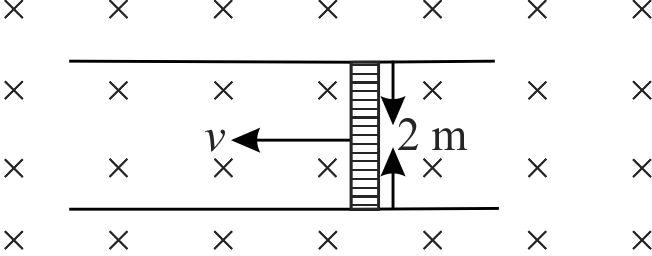358727 The magnetic flux \({\phi}\) through a metal ring varies with time \({t}\) according to \({\phi=3\left(a t^{3}-b t^{2}\right) T m^{2}}\) with \({a=2 s^{-3}}\) and \({b=6 s^{-2}}\). The resistance of the ring is \({3 \Omega}\). The maximum current induced in the ring during the interval \({t=0}\) to \({t=2 {~s}}\) is
358730
A rod of length \(2\;m\) slides with a speed of \(5\;m\;{s^{ - 1}}\) on a rectangular conducting frame as shown in figure. There exists a uniform magnetic field of \(0.04\;T\) perpendicular to the plane of the figure. If the resistance of the rod is \(3 \Omega\). The current through the rod is
358727 The magnetic flux \({\phi}\) through a metal ring varies with time \({t}\) according to \({\phi=3\left(a t^{3}-b t^{2}\right) T m^{2}}\) with \({a=2 s^{-3}}\) and \({b=6 s^{-2}}\). The resistance of the ring is \({3 \Omega}\). The maximum current induced in the ring during the interval \({t=0}\) to \({t=2 {~s}}\) is
358730
A rod of length \(2\;m\) slides with a speed of \(5\;m\;{s^{ - 1}}\) on a rectangular conducting frame as shown in figure. There exists a uniform magnetic field of \(0.04\;T\) perpendicular to the plane of the figure. If the resistance of the rod is \(3 \Omega\). The current through the rod is
358727 The magnetic flux \({\phi}\) through a metal ring varies with time \({t}\) according to \({\phi=3\left(a t^{3}-b t^{2}\right) T m^{2}}\) with \({a=2 s^{-3}}\) and \({b=6 s^{-2}}\). The resistance of the ring is \({3 \Omega}\). The maximum current induced in the ring during the interval \({t=0}\) to \({t=2 {~s}}\) is
358730
A rod of length \(2\;m\) slides with a speed of \(5\;m\;{s^{ - 1}}\) on a rectangular conducting frame as shown in figure. There exists a uniform magnetic field of \(0.04\;T\) perpendicular to the plane of the figure. If the resistance of the rod is \(3 \Omega\). The current through the rod is
358727 The magnetic flux \({\phi}\) through a metal ring varies with time \({t}\) according to \({\phi=3\left(a t^{3}-b t^{2}\right) T m^{2}}\) with \({a=2 s^{-3}}\) and \({b=6 s^{-2}}\). The resistance of the ring is \({3 \Omega}\). The maximum current induced in the ring during the interval \({t=0}\) to \({t=2 {~s}}\) is
358730
A rod of length \(2\;m\) slides with a speed of \(5\;m\;{s^{ - 1}}\) on a rectangular conducting frame as shown in figure. There exists a uniform magnetic field of \(0.04\;T\) perpendicular to the plane of the figure. If the resistance of the rod is \(3 \Omega\). The current through the rod is
